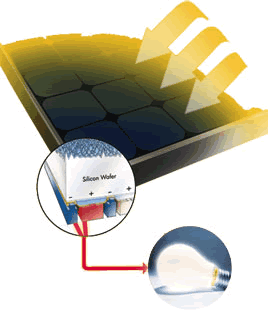Jump to navigation
How Solar Works
Energy radiating directly from the sun has always been available to us.

Since the development of the first solar cell in 1954, its usage
has continued to grow steadily along with its efficiency. If you’ve ever used a
calculator that operates without a battery, you’ve seen solar energy at work.
Solar calculators use solar cells to harness light from the sun. In this same
way, people can use solar energy on a larger scale–to power their homes and
buildings.
How do solar cells convert sunlight into electricity? These
photovoltaic (PV) cells are made up of special materials, particularly the
element silicon, which allows them to absorb light. Silicon is known as a
semiconductor due to its absorptive and insulative properties.
In solar cells, silicon is placed under non-reflective glass to
collect photons (units of electromagnetic energy) from the sun. The PV cells
have one or more electric fields that essentially force the electrons harnessed
by the absorption of sunlight to move in a certain direction. This movement of
electrons, called a current, is further guided by metal contacts on the PV
cell.
Individual solar cells are packaged into solar panels that can be
mounted on your roof or on the ground to take advantage of the free energy
landing there every day.
Photovoltaic systems can either be standalone
or grid connected. In a grid-connected system, the PV cells produce power in
parallel with the electrical utility (i.e. your local power company), which uses
a utility grid to connect and distribute power to its users.
How
Solar Works In Your Home or Business
 After installation, solar panels absorb the sun's rays, even
on cloudy days, and convert sunlight into usable electrical energy. Next, an
inverter converts the DC current from the solar panels to AC current for use
throughout your home. Your solar system is connected to the utility grid through
a standard utility meter that tracks your net power use while taking into
account the electricity production from your solar system.
After installation, solar panels absorb the sun's rays, even
on cloudy days, and convert sunlight into usable electrical energy. Next, an
inverter converts the DC current from the solar panels to AC current for use
throughout your home. Your solar system is connected to the utility grid through
a standard utility meter that tracks your net power use while taking into
account the electricity production from your solar system.
During sunny days when your solar system generates more power than
your home needs, your electric meter actually reverses direction and spins
backwards as you lend that energy to the utility grid. When the sun goes down,
you effectively retrieve that energy when you need it. This process is called
net metering.
How powerful is solar energy? When you consider that
enough sunlight falls on the earth's surface each minute to meet the world's
energy demands for an entire year, it's clear that sunlight represents a great
alternative energy opportunity.
Today, solar power is considered the most abundant, reliable,
clean source of all known energy sources, and we've only just begun to tap its
potential.